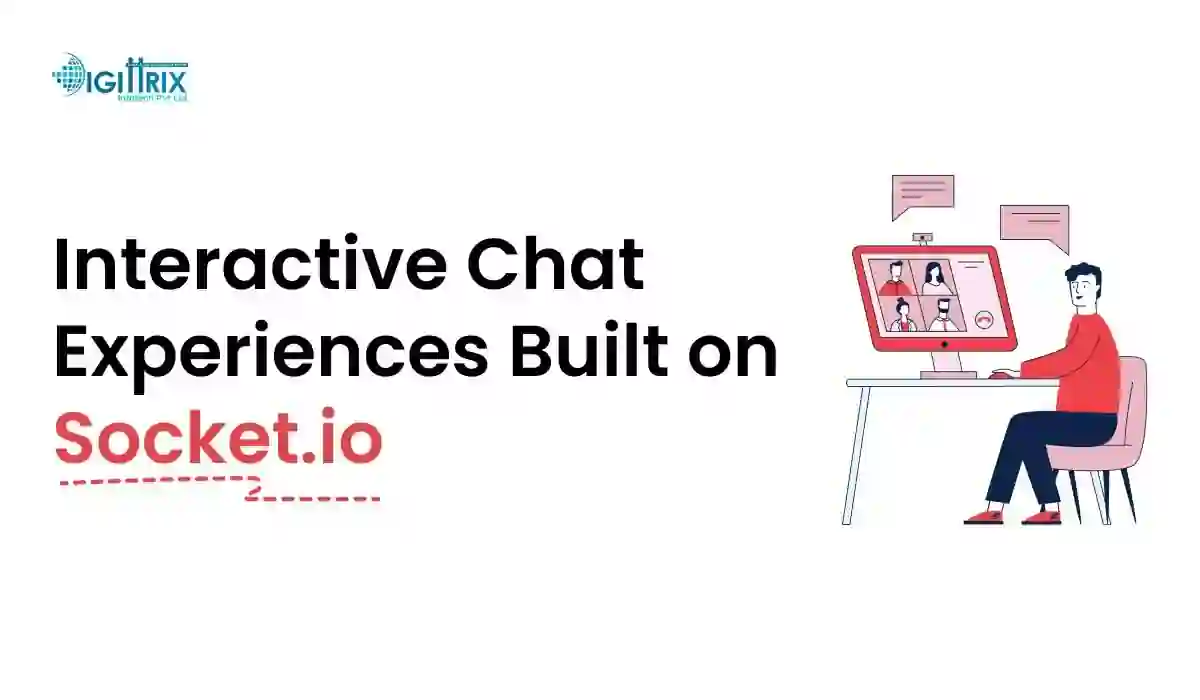Live chat apps enhance real-time communication for businesses, improving customer support and engagement across mobile, web, and desktop platforms using tools like Socket.io.
Highlights
An enthusiastic developer and skilled business management expert with over a decade of experience in the field

Live chat apps are a common feature in today’s mobile and web applications. Whether it’s a customer support tool, a messaging platform, or a social application, real-time chat enhances user communication. Many companies and developers are now seeking to build a live chat app using Socket.io due to its real-time capabilities.
In this article, we will walk through the process of building a live chat mobile app using Socket.io without delving into technical terms or code. If you are a business owner, project manager, or even a beginner interested in live chat app development, this guide is for you.
Curious about app development costs in New Zealand? Check out this 2025 cost guide by Digittrix!
A live chat app is a platform that allows users to communicate instantly with one another. Commonly used in customer support scenarios, live chat is also a fundamental feature in apps like WhatsApp, Telegram, and Messenger.
For businesses, having a live chat option helps enhance user engagement, provides quick support, and resolves issues real-time. It’s essential for industries that require immediate attention from their customers. According to Forbes, real-time communication boosts customer satisfaction by 42%, enhancing business interaction.
Socket.io is a JavaScript library used to enable real-time, bidirectional communication between web clients and servers. It works with Node.js and can be used for building applications like chat apps, live video streaming, online games, and more.
The main advantage of using Socket.io for live chat mobile apps is its ability to maintain an open connection between the client and the server, allowing for fast data transfer. When a user sends a message, it is immediately delivered to the other user without the need for refreshing the page.
Socket.io is based on WebSockets, a protocol that allows for persistent connections. It’s a perfect tool for building scalable, fast chat applications.
Building a live chat app can significantly improve communication between businesses and their clients, or even for internal team collaboration. Here are some reasons why you might want to build a chat app:
If you are into on-demand app development, adding live chat to your application can help improve user interaction and increase the app’s value. Zoho reports that businesses using live chat see a 48% improvement in customer retention and loyalty.
Building a live chat app requires a set of essential features to ensure smooth and effective communication. Some of these key features include:
Socket.io is useful because it establishes a two-way communication channel. This means that when User A sends a message, User B receives it instantly, without the need to refresh the page or wait.
This makes it perfect for developing live chat apps. It is compatible with all modern browsers and functions on both web and mobile platforms. As per FreshDesk, live chat apps reduce response times by 70% compared to email support.
Additionally, Socket.io handles things like:
To start building a live chat app, you need to plan the architecture and decide on the technologies. Here's a step-by-step conceptual approach.
The first step in the app development process is to set up the environment. You will need to install Node.js for backend server functionality and Socket.io for real-time communication. If you are building a mobile app, you can use frameworks like React Native, Flutter, or Ionic to create cross-platform applications for both iOS and Android.
For the backend, you typically set up a server using Express or NestJS with Node.js. The server manages user connections, stores messages, and communicates with the frontend.
Once the server is ready, integrate Socket.io into your application. Socket.io enables two-way communication between clients and servers. It is highly scalable, making it ideal for chat apps where multiple users need to interact simultaneously.
You will also need to manage connection events, such as disconnections and reconnections, in case the user loses the connection to the server.
The chat interface should be simple and easy to use. It should include the following elements:
This interface can be developed using frameworks such as React, Vue, or Angular for the frontend. Additionally, Flutter or React Native can be utilised for a mobile app version.
To store user data, messages, and other relevant information, you need a database. You can use MongoDB, which is a NoSQL database, or MySQL if a relational database is required. A chat app necessitates an efficient database design to securely store messages, media files, and user data.
Once the basic app is built, you can add more advanced features:
There are many tools to build chat apps, but Socket.io offers unique advantages:
These benefits make it ideal for businesses seeking to create an efficient and cost-effective live chat app.
Working with the right app development company is important. A good team will:
Whether you’re a startup or an established brand, hiring a chat app development company with genuine expertise in creating real-time apps can save time and money.
The cost depends on several factors:
On average, a basic chat app utilising Socket.io takes between 4 to 8 weeks to develop. Costs range from USD 5,000 to USD 25,000 or more (INR 4,27,000 to INR 21,34,000 or more), depending on its complexity.
For businesses already investing in on-demand app development, incorporating chat functionality can significantly enhance user interaction.
With the increasing demand for real-time customer service and communication, live chat apps are here to stay. Industries such as healthcare, e-commerce, education, and logistics are all adopting chat-based solutions.
If you belong to any of these industries, having your live chat mobile app is a practical step. It enhances your operations, customer interaction, and user satisfaction.
Building a live chat app using Socket.io offers a flexible and scalable solution for real-time communication. Whether you’re integrating live chat into a mobile app, website, or both, the technology behind it is simple and efficient. By using tools like Node.js, MongoDB, and React, developers can quickly build a robust real-time communication app for any platform.
To get started, consider working with an app development company that has experience in chat app development. They will help you define your needs, select the right technologies, and deliver the best results. Live chat apps are now a must-have for many businesses, and with the right approach, you can build an app that will meet user expectations and grow with your business.
Want to create a seamless live chat app like WhatsApp, Messenger, or Slack? Digittrix can help you build it fast and smart using the powerful Socket.io library! From one-on-one messaging to group chats, we develop highly interactive and feature-rich platforms that run flawlessly on Android, iOS, and web.
Whether you're planning a casual chat app like Omegle, a professional team collaboration tool, or a customer support platform, Digittrix has the experience to bring your idea to life. With real-time messaging, instant notifications, secure communication, and full customizability, your app can stand out in the competitive market.
With 14+ years of expertise, we understand what it takes to build a scalable and user-friendly live chat application, be it for social networking, customer support, or team collaboration.
Start your chat app journey today! Call us at +91 8727000867 or write to us at digittrix@gmail.com to schedule a free consultation.

Do you need help in Mobile App development?




Join over 1500+ businesses we've already helped!
Socket.io is a JavaScript library that enables real-time, bidirectional communication between web clients and servers, ideal for building chat applications.
Key features include real-time messaging, user authentication, group chats, push notifications, media sharing, and multi-platform support.
Socket.io maintains an open connection between the client and server, allowing for instantaneous message delivery without refreshing the page.
Technologies include Socket.io for real-time messaging, Node.js for backend, MongoDB for database, and frameworks like React or Flutter for frontend development.

©2025Digittrix Infotech Private Limited , All rights reserved.